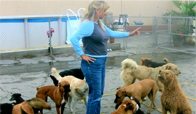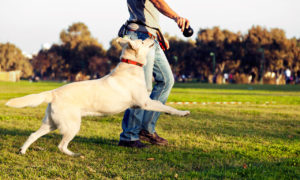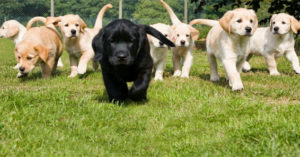Take this survey and be the leader
By Delores Burton—K9 Campus
Are you guilty of doing or allowing any of the following? (Definite no, nos, especially if you have a dog that tends to be aggressive.) These things may seem harmless or insignificant to you, but they mean lots to a dog.
1. Does he growl, snarl or snap at you if you try to move him?
2. Did you give him lots of treats, love, hugs, talking in nice tones even though he was doing nothing but lying there looking cute?
3. Does he sit on the sofa? Perhaps you let him have a nice comfy spot on your bed!
4. Does he lay in walkways blocking your way? Maybe instead of making him move, did you step over him?
5. Have there been times you have called him to come, or told him to sit, and he ignored you, and you did nothing about it?
6. Did you ever play tug of war, and let him win and play with the toy afterward?
7. Are all members of your family in agreement and consistent with the same method of training?
8. Do you allow him to circle you or excessively lick you?
9. Do you let him have some scraps from the table?
10. Do you let your dog enter the door, gate, car, before you?
11. Do you open the door for your dog when he scratches to be let in?
12. Do you automatically pet your dog when he paws at you or nudges you with his nose?
13. Do you comfort him and pet him and say “It’s Okay” when he barks at company?
If you answered yes to any of these questions, the dog is misbehaving or even shows aggression because he mistakenly thinks he is the Alpha dog in your house, or he is in conflict because you are sending him mixed messages. What may be clear to you can be completely confusing to your dog. You may unknowingly be sending conflicting messages to your dog, whereby he will then make up his own mind.
 Answers to Survey:
Answers to Survey:
1. A dog should never be allowed to show even the slightest hint of aggression. If your dog displays that type of behavior, he should receive the highest form of discipline. If you are unable to do this with confidence, perhaps a muzzle is for you. All you have to do is win a couple of disputes and it won’t be an issue any more. If you are in doubt about how to administer a proper correction, seek the advice of a professional.
2. You can give him all the love you want, just make him earn it. Make him earn everything before you give him any affection or food (for example, make him sit before you pet him, or before you give him his food, or let him in the house.) He must rely on you for everything.
3. As a general rule, your dog should never sit on the sofa or bed. Occasionally there are exceptions to the rule with the more docile dogs. However, in the dog world, the dog that is lying equal to your level or higher up is the Alpha dog. You always want to be at least a head above your dog.
4. Make your dog moves if he is in your way. Do not step over him or go around him.
5. Never give a command you know you can’t or won’t enforce. Enforce every command. Make him obey on the first command. Do not repeat, or make your command sound like a request or a question. If you give him an option, he will ignore you. It takes getting away with something just once for him to challenge your authority.
6. Never play tug-of-war with an aggressive dog. It kicks in their instinct to compete and challenge. If you allow your dog to win a tug-of-war and take the toy off to a corner, as far as he is concerned, that is his prize, his kill, and he may challenge you if you try to take it from him. If you do play tug-of-war, you must always win in the end.
7. All members of the family should be consistent with training. All humans are above your dog. He must respect all members of your family. He must like who you like.
8. Circling and excessive licking are signs of dominance, however passive it may seem to you. An occasional kiss is acceptable but you must stop excessive licking. If he is circling you or your guests, cut him off. To the dog, that is like “herding his flock”.
9. Never feed him scrapes from the table. Try to feed yourself before you feed your dogs. If that is not practical, he can only eat when you give him permission to eat.
10. Doors and gates are very significant to dogs. To them it means, “whoever goes through the door first is leader”. You always go through doors first, or give them permission to go ahead of you.
11. Do not open the door for your dog when he scratches to be let in. He is giving you orders when he does that. When you open the door for him, it reinforces bad behavior. Either ignore him until he stops, then let him in, or, make it your idea. Go to the door, make him sit and then invite him in. Do not let him come in as soon as the door is opened. He must wait to be invited.
12. If your dog wants to be pet by nudging you with his nose or pawing at you, ignore him, or at the very least, make him do something to earn that attention, otherwise you will have a pest on your hands.
13. When you try to calm a dog down while he is growling or barking by petting him and saying “It’s okay”, you are reinforcing that bad behavior. In his mind, you are encouraging him to continue. Never pet a dog that is growling or barking.
HELPFUL HINTS
Dogs show love by showing respect, and you can do things to gain your dog’s respect, and thereby his trust.
MOST IMPORTANT— Exercise, Exercise, Exercise. About 50% of his interaction with you should be some form of working off excess energy. A minimum of ½ hr. walk, chasing the ball, training, playing—whatever it takes to tire him out. It also puts you in the leadership role and builds a bond between you and your dog. Exercise also releases endorphins to relax him so he is not so uptight. When walking, swing your arms naturally. If your dog is not in a heel position then he should be walking freely behind you or beside you. That is a sign of respect.
Next, you give boundaries and limitations. Show what is acceptable in your world and what is not and enforce them always. Never let anything slide, or your dog will constantly test you.
If you remain calm and assertive, your dog will be calm and submissive. Dogs do not follow emotional or affectionate leaders. They follow calm, confident leaders.
After you have exercised, done some sort of leadership activities–then you can share affection. Always in this order: exercise, discipline, affection.
You are doing your dog a favor by taking away the responsibility for him to make decisions. You must make all decisions for your dog. Your dog should always look to you for guidance.
You decide when playtime starts and when it is over.
Remember: You cannot impose human feelings and thoughts on your dog. They do not reason like humans. They rely on their instincts, smell, body language and energy.
Timing is crucial when correcting your dog. You must catch him in the act, or you must deter his bad behavior BEFORE it escalates. You must break his concentration and redirect. This can be done by touch, sound, body language, a pop on the collar, a strong “watch” command—whatever works. When you give a correction, do not get mad or emotional. You correct, the dog submits, then let it go. You walk away. Do not let the dog walk away from you. If he wants to go hide and cool off, that’s fine, but you must be the one to dismiss.
If Your Dog is Aggressive:
Take him to the vet to rule out the possibility of a health problem.
Neutering will usually help calm an aggressive dog, especially the males. Get him neutered before he establishes bad behaviors and they become a habit.
With an aggressive dog, look for a lower protein diet. High protein may give your dog too much energy. There are low protein dog foods that are healthy. Do not feed chicken or lamb. Some dogs are sensitive and may have a negative reaction.
If your dog is nervous or aggressive, perhaps you might want to try a natural herb called Rescue Remedy. Rescue Remedy is most often used for emergencies or stressful situations. Helps replace panic with control. Restores focus and clean head when dazed. Helps calm and restore sense of peace, neutralizes the effects of trauma. The good thing is there are no side effects, it does not drug your dog, it does not change his personality, it does not interfere with other medications. You can buy it at health food stores. It works on some dogs, and some it does not. If you give it to him on a treat, it usually takes effect within 15 minutes.
Be the pack leader your dog wants you to be!

IF YOU ARE UNABLE TO COMMIT TO THESE GUIDELINES AND THE HELP HE NEEDS, THERE ARE VERY FEW OTHER OPTIONS.
